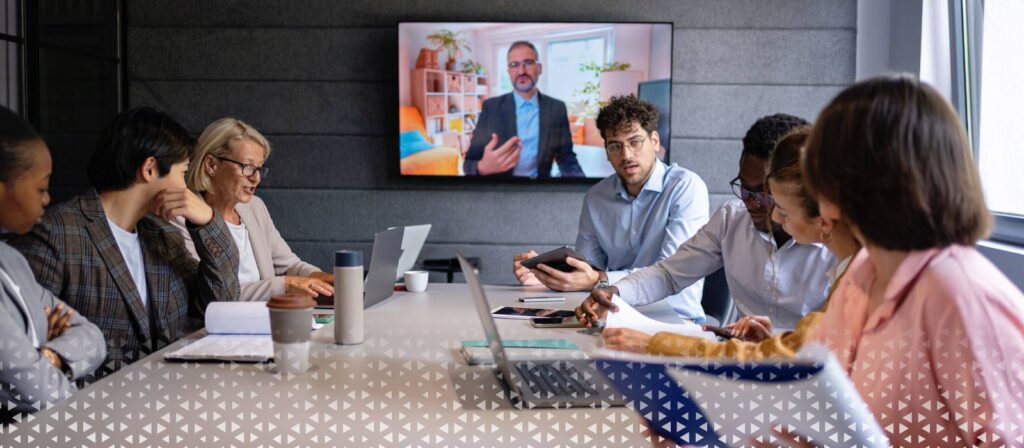Gone are the days of cramming as many people as possible into a stuffy boardroom. Today’s meeting room setup styles now take into account a wide variety of factors, to accommodate a wide variety of purposes and goals. This in turn leads to a more exciting and wider variety of meeting room design than in the past.
Namely, with the rise of the hybrid workplace and other flexible work environment types, employees are now using the physical office differently than ever before. That means they’re using collaboration spaces differently, too.
To keep pace, smart companies are experimenting with new meeting room styles. This is along with the technology and systems they use to support collaboration strategies in the workplace.
In this article, we explore the latest meeting room setup styles. We review which work best for different types of meetings, cultures, and approaches to work. We’ll be focusing on physical aspects of meeting rooms like seating and layout, as well as the office workplace technology and equipment required to make them most successful.
New ways of working impact meeting room setup styles
From a 30,000 foot view, we all know what hybrid employees need… An easy way to book desks and rooms when they’re in the office, an up-to-date home computer with reliable wifi that connects them to a good digital workspace when they’re working from home (and perhaps a stipend to cover these costs), extra wayfinding to help them navigate spaces they use less frequently and therefore are less familiar with. But how these elements all play out will look different from hybrid office to hybrid office. And also from company culture to company culture.
Meanwhile, as companies adapt to hybrid work and adjust their workspaces to follow suit, they’re learning that the physical workspace still has an outsized role to play in the future of work. Perhaps nowhere is this more glaring than in meeting rooms. This is where so much of the face-to-face work that builds culture—brainstorming, strategizing, group discussions exploring the nuances of your weekend plans—takes place.
The rise of hybrid and distributed work does mean that fewer people are using the office on a daily basis. This is leading to less demand for physical collaborative workspaces.
So conference rooms today aren’t just about the people physically present, sitting at conference tables. Meeting room design now incorporates both better technology and better layouts to ensure that everyone is able to collaborate and innovate together, whether or not they’re all in the same room.
Thankfully, assuming they’re following hybrid meeting best practices, video conferences can be just as fruitful as their fully face-to-face counterparts. Videoconferencing can reduce travel costs and save time; some research also suggests it can improve collaboration along with work/life balance. The ability to record and archive online meetings can also be helpful.
In other words, a hybrid workplace still needs meeting rooms. Even though the way those employees may use those rooms may be in flux. Meeting room setup style in offices today should be purpose-driven, using data and technology to make better spaces for everyone.
Moreover, it’s the companies that see this disruption as an opportunity to experiment with new ways to serve employees that are in the perfect place to optimize both their hybrid workplace and employee experience.
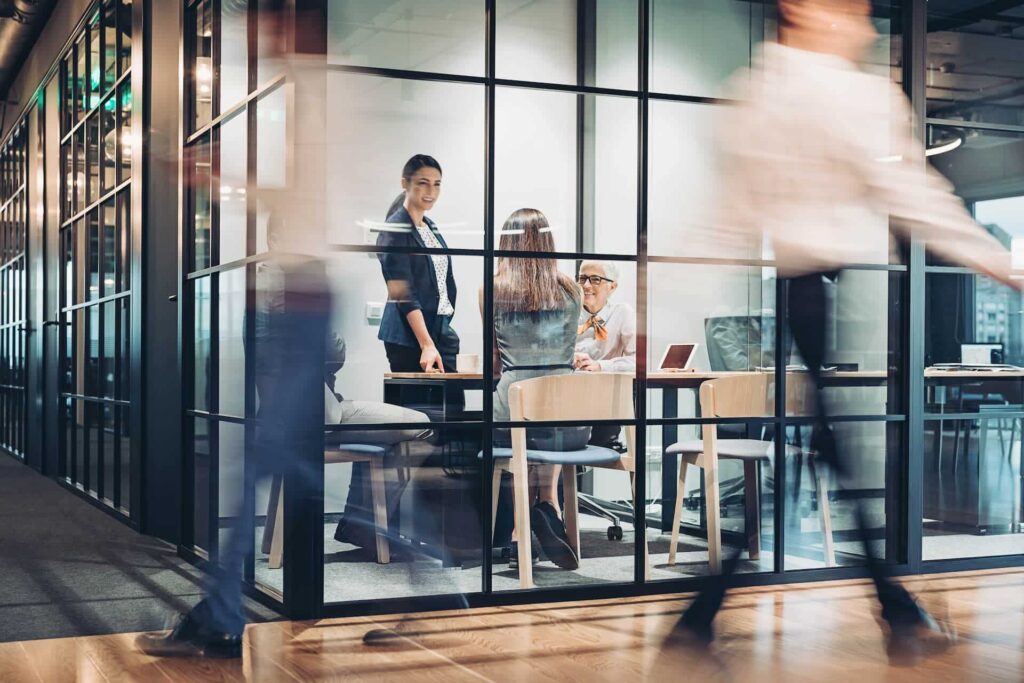
Every office (and every conference room) is unique
Industry benchmarking—the old standby for facility management and space planning—is becoming less and less relevant in our new age of flexible working. It’s no longer a given that just because you’re in a similar industry or have a similar number of employees, that you’re going to have the same space requirements (meeting rooms or otherwise).
Conference room layouts have traditionally been dictated by the number of people who need to use them at one time. But thanks to the rise in remote/hybrid work and videoconferencing, the number of people who use conference rooms on a regular basis can fluctuate dramatically. And depending on their chosen hybrid work model, any or all meeting rooms may now need to accommodate team members who aren’t physically present.
Fostering a more flexible work culture
Culture matters, too. Many companies today are working to foster a more flexible work culture to boost talent retention and attraction efforts (among other benefits). But they still want the office to be a place for collaboration and connection. Offering offices filled with inviting spaces that employees actually want to use can help entice those into the office who might rather stay home in their pjs otherwise.
Regardless, what works best for one company won’t work for every company. This is why testing and iterating (along with collecting data and surveying employees), is so important.
For example, OfficeSpace client HUB International reoptimized their real estate by setting an example using their company headquarters. With over 600+ offices (or Hubs) and a culture that placed high value on private offices, Chief Procurement and Real Estate Officer Jay Sklar wanted to improve space utilization without mandating sweeping changes across the organization.
So beyond offering new desk and room booking technology to any office that wanted it, the company also redesigned their headquarters. The new space now includes shared desks and more private offices than ever before. But it has a catch: these offices are open to a broader list of office-eligible staff. Sklar reports that staff now love ducking into these new private spaces for meetings and whiteboard sessions. They’re proving to be much more efficient than booking a whole conference room. Or disturbing nearby colleagues for these quicker meetings.
So for HUB International, a calculated rollout and offering more bookable spaces for very small groups was their best solution. But the key takeaway from HUB’s example should be their willingness to experiment, test data, and find a bespoke solution for their unique culture.
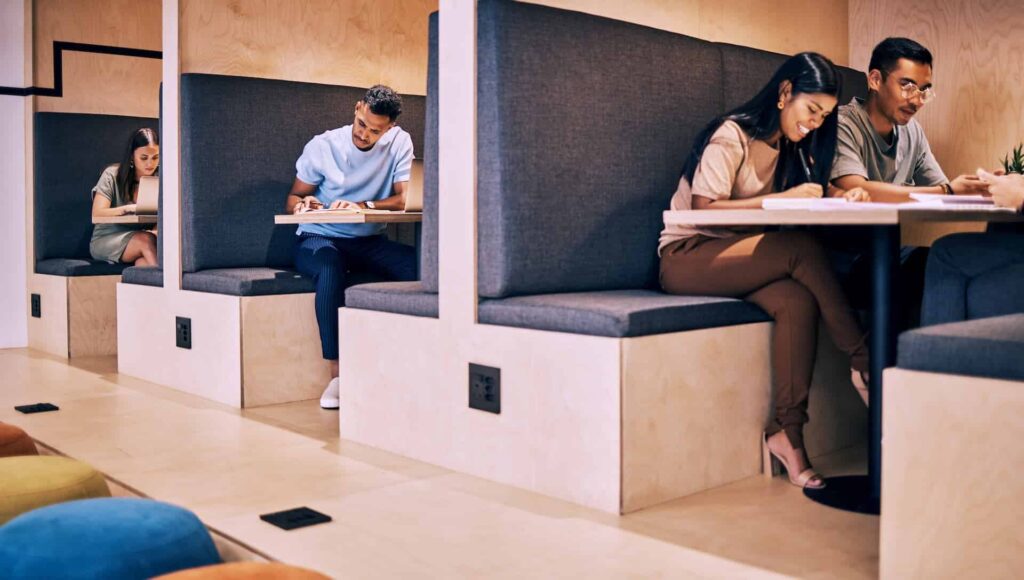
The purpose of meeting rooms should dictate their setup style
Some things are universal. And there will always be certain ‘must-haves’ for any meeting room. But without comfortable seating, good acoustics, and hopefully a little privacy, meetings are going to be stymied before they start.
Having a solid strategy for creating unique room names can also help with both wayfinding, branding, and culture efforts. NIKE names its rooms after popular athletes, for example, while Pinterest ops for names based on their most popular pins.
And thanks to hybrid work, companies need to ensure they have at least some rooms on offer that allow for mixed presence attendees. This is why it’s not surprising that the OfficeSpace Workplace Strategy Report 2023 finds that many companies are planning to add more collaboration technology to their workplaces in the coming year.
But beyond these key elements, it’s the purpose of a meeting room that should most impact its setup style. Client-facing rooms need to make a good impression, for instance, while smaller groups tend to prefer smaller huddle rooms.
Bespoke seating arrangements
Specifically, the following common purposes for rooms tend to require bespoke seating arrangements:
- Private calls, which need privacy, as well as a phone and/or videoconferencing tools; given the rise in open office layouts, many companies now build-in private phone booths specifically for this purpose
- Huddles, 1:1, and stand up meetings, which only need small spaces (but preferably no smaller than 100 square feet), with a small table and chairs, and can also simply be a section of the office that is partitioned with furniture, plants, and/or sound blocking panels
- Brainstorming and breakout sessions, which can benefit from whiteboards (digital ones are always better), as well as enough hookups to make it easy for participants to ‘BYOD’ (‘bring your own device’)
- Team building, training sessions, and company wide meetings, which may need special audiovisual equipment to accommodate remote team members (and potentially create webinar recordings for later use)
- Social connections, which require social spaces like lunch rooms and game rooms, often best designed by soliciting extra employee input
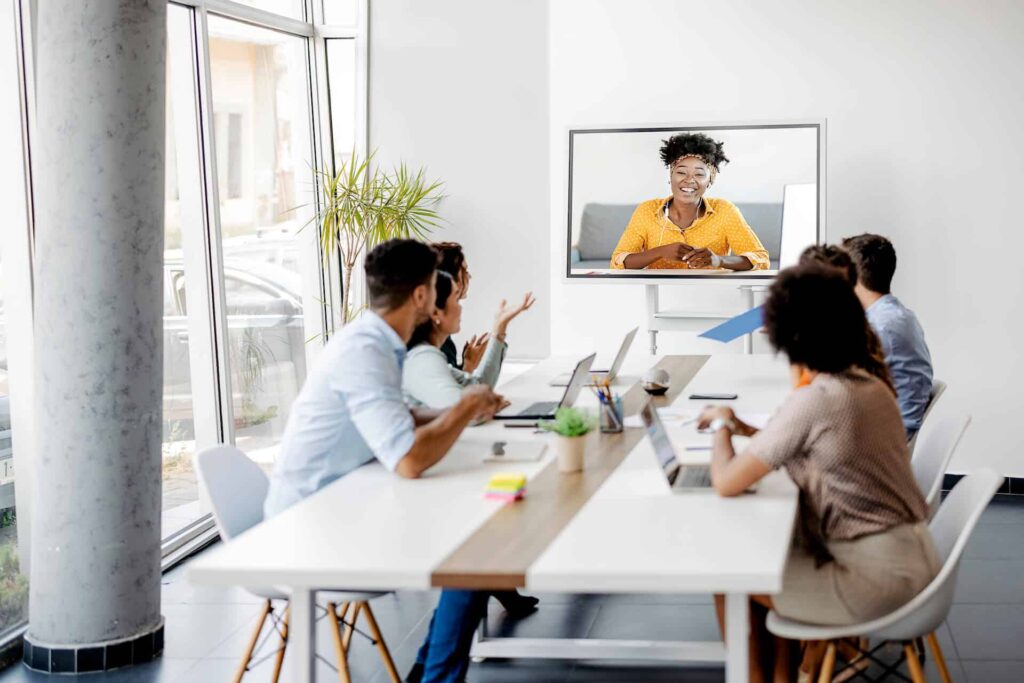
What are the different conference room setup styles?
While bearing in mind that companies can now experiment with their meeting room setups like never before, there are some default styles that stand the test of time. Largely dictated by the number of attendees in a given meeting, most meeting rooms will still draw from one (or more) of the following nine basic conference room styles.
1. Auditorium style layout
Sometimes called theater style layouts, this layout is best for large scale meetings. This can include things like town halls, all-hands meetings, and guest speakers. It also lends itself easily to online presentations.
In this style, rows of chairs line up to face one speaker. Note that since this style uses seats without any desks or tables, it’s not conducive for note-taking.
2. Banquet style layout
Similar to an actual banquet hall, this layout features several tables (which are usually round) in a large open space. Each table usually accommodates around eight seats or so. This style allows for networking and group interaction, and companies often use this style for meals and refreshments.
Sometimes, these round tables only have seats on one side (forming what are called crescent or half rounds). This way, everyone can be facing the front of the room. This layout variation is more likely to be chosen if there will be a presentation. This way, no one has their back to the presenter.
3. Boardroom style layout
Sometimes called a conference style layout, this is the prototypical style for meeting rooms. It consists of one large table (usually a rectangle or oval), with seats on all sides. This style lends itself to up to 25 people, allowing for focused discussions and brainstorming.
4. Chevron style layout
This is a layout where multiple rows of tables or chairs are in a ‘V,’ fanning out from a center aisle. It offers similar benefits and uses as the classroom style (below). But the chevron-inspired layout may work better for single screen presentations at the front of the room.
5. Circle and semicircle layout
This is a very simple layout, in which chairs alone form a circle or semicircle. This style works well for small to medium groups where participation is encouraged, but people don’t need to take notes. It’s similar to the U-shape style (below), but without tables.
6. Classroom style layout
This layout mirrors those used in education. Here, desks are in small rows, all facing a focal point at the front of the room (the teacher in a school room setting, the leader or facilitator in an office setting). While this style is good for note-taking, learning, and audience participation, it’s not typically a great design for peer-to-peer participation or brainstorming.
7. Hollow square style layout
Also known as a closed U layout, this setup arranges tables into a square or rectangular shape. Chairs are placed along the outside edges, so that everyone is facing each other. Thanks to the table, note-taking works well here.
8. Team tables style layout
Some call this a cluster style. It’s so-named because it clusters people around several tables, all of which are in one room. This works well for when small groups are working on separate but interrelated projects.
9. U-shape style layouts
Finally, versatile U-shape layouts arrange tables into a square U shape. In other words, square and/or rectangular tables are arranged to form a three-sided rectangle (which resembles the letter U).
Similar to the hollow square layout, participants here sit around the outside edges of the tables. This way, they have the table in front of them to take notes. In this case, though, the fourth side of the rectangle remains open for the presenter, who can also walk into the middle space as needs dictate.
What is the difference between a conference room and a meeting room?
While the terms ‘conference room’ and ‘meeting room’ are often used interchangeably, there are some colloquial differences between the two.
Typically, the term ‘conference room’ is reserved for rooms that accommodate larger groups of people, and/or for rooms that accommodate more formal meetings.
Meanwhile, ‘meeting rooms’ can be much smaller (even simply for two to three people). And they tend to be considered less formal than conference rooms.
That said, try not to get too hung up on names. The important thing is that collaboration in the workplace is supported with good spaces that are specifically designed for the people using them.
What is a boardroom setup style?
A boardroom setup style is one that’s all about the big classic table that takes up an entire room, surrounded by what are typically big, cushy, leather swivel chairs. It’s called a ‘boardroom’ style, because this is the meeting room style that is traditionally reserved for board meetings. This is along with other ‘important’ gatherings with other ‘important’ people.
That said, since this style can accommodate around 25 people, it can work well for any type of meeting that requires this amount of people.
Since everyone gets a seat at a table, they’re all able to take notes.
Since they’re all facing each other, participation and collaboration is easy.
And since it’s possible to seat a leader and/or moderator at one end of the table, it can accommodate a wide variety of presentations and brainstorming sessions.
In this way, the boardroom setup style is one of the more versatile styles on offer. And it’s likely here to stay. Especially if they have audio-visual technology and modern design elements, they can easily move past their stuffy historical associations and into modern office floor plans.
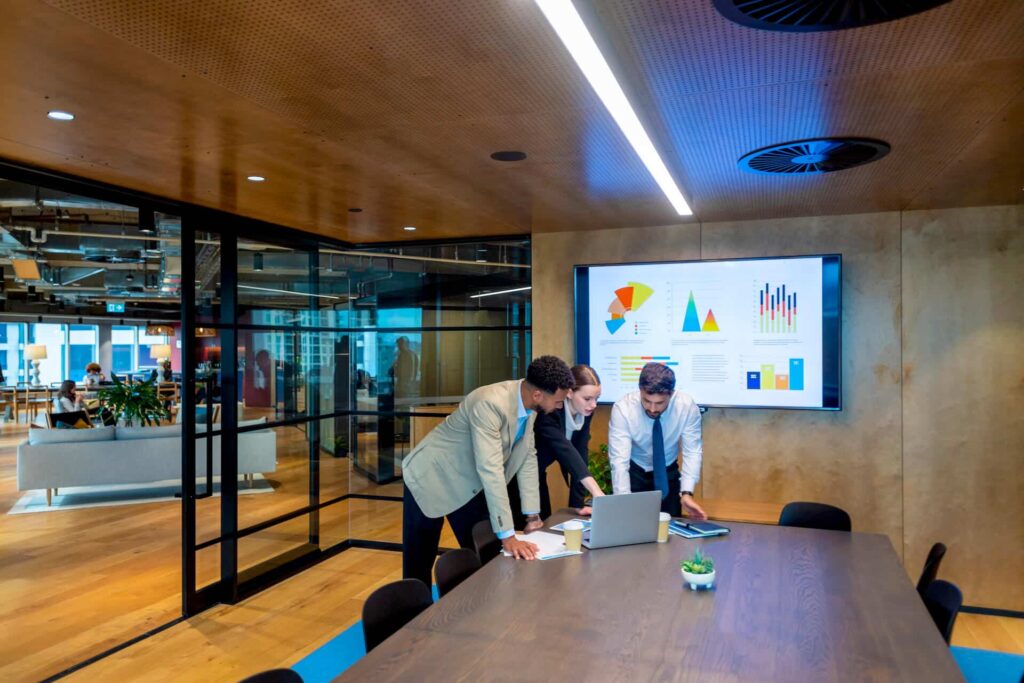
How to create a meeting room setup style strategy (hint: use good data)
Pre-pandemic and the resulting explosion of remote working, it was pretty easy to gather everyone in-person, even for last minute, ad hoc meetings. But today, whether they’re building new rooms or redesigning existing ones, space planners have lots to consider. What is the meeting room being used for, how are employees expected to use the physical workspace, do we need to account for remote attendees, and what are the options for meeting room setups?
Yes, there are seemingly endless possibilities now. Thankfully, there’s also a way to cut through the noise.
Simply put, collecting and analyzing the right data can help companies better optimize all elements of their workplace strategy, including plans for meeting rooms.
For example, when FMs are able to analyze data from room booking software, perhaps overlaid with employee survey data, they can start to see what rooms are most popular—and build more of them.
Perhaps certain setups are more popular, or employees gravitate to rooms with better audio-visual equipment. Or maybe it’s just a case of some rooms having more comfortable seats, or better wifi.
That’s how one OfficeSpace client was able to see that employees were booking rooms that were setup for video conferencing. Based on that data, they added Zoom integrations to several huddle rooms to serve their hybrid workforce better.
Similarly, if certain teams or departments have a ghost room problem, companies can figure out if the issue is with the rooms themselves, or with the tools available to them in their meeting room booking software (or perhaps the lack thereof).
Whatever the issue, it’s data that gets at the root and points the way forward.
Finally, companies need to be willing to not only collect data, but to also experiment and follow where the data leads them. We’re in a new and largely untested world. It’s likely that you won’t get things exactly right on the first go. And that ok, as long as you set some goals and try to keep meeting them
In fact, the only thing that’s not ok is to pretend that nothing has changed. Or to put off developing a new strategy.
“In terms of what’s successful in workplace planning, taking a ‘no policy’ approach doesn’t tend to work very well,” says Kathleen Williams, Senior Product Manager at OfficeSpace. “It’s much more helpful to start with a meeting room policy, and then use analytics and a good feedback loop to see if it’s working or not.”
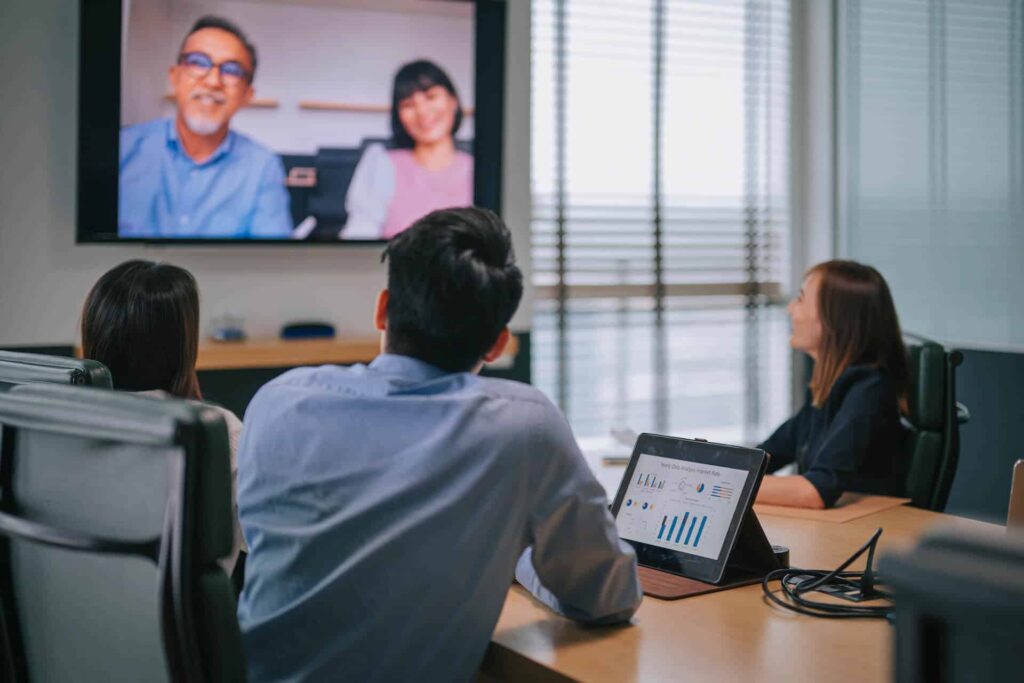
Three elements to include in every meeting room setup style
Yes, designing meeting spaces for a distributed workforce might be more challenging. But there’s still no doubt that meeting room setup matters. In fact, a Gensler Research Institute Experience Index survey of 4000 people found that people who describe a space as ‘extremely well designed’ rate their experience almost 2x as high as those who said space was ‘poorly designed.’
Meeting rooms that are set up with the three following elements are those that stand the best chance of elevating that experience for those who use them.
1. Technology
It’s hard to believe, but 30% of companies hadn’t used web conferencing before the pandemic.
Today, of course, it’s hard to find a company that’s not using (or planning to use) hybrid workplace technology in some capacity. This is certainly true with meeting rooms. They now need to include both hardware and software to allow for better hybrid meetings. And that hardware and software needs to be well integrated into any meeting room design.
According to the latest research, the two biggest barriers to adopting video conferencing are that meeting rooms aren’t equipped for video, and that the rooms with video always have bookings.
So, like our OfficeSpace client example shows, adding video conferencing capabilities to rooms can lead to a big win.
Specifically, any modern meeting rooms that people will use for any amount of hybrid meetings need the following essential technologies:
- High quality hardware, including display screens, good speakers and microphones, and sometimes a monitor/TV enabled with hybrid options
- High quality software and essential integrations like Zoom or Microsoft (such as Zoom meeting calendar integration) and other workplace collaboration tools
- IoT sensors and other data-sources to collect information on actual room use
Collecting data in particular will be helpful for making better rooms over time. Whether that data is coming from room booking software or from occupancy sensors (or, ideally, from both layered together), space planners can use it to iterate and create more rooms that directly meet the needs of the people using them in-office.
2. Comfort
Since most companies believe that collaboration is important in the workplace, it follows they want to encourage more of it. But who wants to sit through a business meeting in bad seats at a messy table?
So perhaps it goes without saying… But offices need to ensure they’re providing clean, comfortable meeting rooms that are welcoming and easy to use.
In short, comfort matters. Ensure ergonomic chairs and tables are provided so that people are willing to spend time collaborating. Make rooms private, pay attention to acoustics, and work with IT to make sure there’s always a good wifi connection (with posted information about how to connect). Provide whiteboards (or interactive whiteboards), projector and laptop sharing capabilities, good lighting, and adjustable temperature.
And just as important, don’t forget the comfort of people who will be attending from home. Like we’ve already covered, they’ll need a good wifi connection too, and digital workplace solutions they can access from anywhere. Many companies now also give their employees reliable headsets and webcams. This helps to ensure they’re always able to participate meaningfully when remote, too.
Finally, meeting rooms (and all equipment therein) always need to be clean and tidy. FM teams may find that having a room reservation system in place helps them keep tabs on which rooms are in use—and when. And therefore which need to be cleaned when, too.
3. Accessibility
Finally, rooms don’t just have to be comfy. They have to be easy to access, too.
Like we’ve covered, room booking software offers many benefits to the company, and many benefits to individual employees, too. Good software will allow them to see what rooms are available, book them, check-in, and cancel as necessary.
Better still if this booking capability is on offer via mobile app, so that employees can book on the fly.
And bonus points if the software and app integrate with wayfinding solutions. Things like wayfinding kiosks and meeting room digital signage that make it easy for everyone to find the spaces they need.
Many OfficeSpace clients find that having a visual directory that lets people see when their colleagues plan to be in-office can also help boost the collaboration in a hybrid office (whether they’re formally booking rooms or not). For example, that’s how employees at HUB International ensure they’re always sitting with the right colleagues for the right projects.
“We have a couple of teams that are highly collaborative and interactive,” says Sklar. “They now use OfficeSpace to figure out how to get everyone in on a particular day, and to make sure they’re sitting together.”

How many types of conference room setup styles are there?
Some workplace strategists focus on six ‘official’ meeting room setup styles. Others expand their lists into nine setups or more. But the reality is that in our new flexible normal, there’s virtually an endless number of options available. That’s because smart companies today are experimenting with new and exciting layouts and technology. Ultimately, this allows for better hybrid meetings and collaboration.
OfficeSpace provides tools to optimize any meeting room setup style. Reach out for a free demo.
Photos: courtneyk, pixelfit, PeopleImages, PixelsEffect, courtneyk, Edwin Tan, EmirMemedovski




